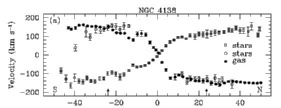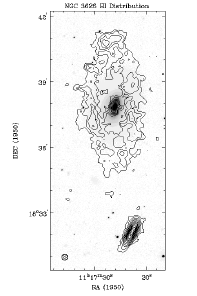Kinematic Evidence for Minor Mergers in Isolated, Normal Sa Galaxies
Sa galaxies are the earliest Hubble types exhibiting clear evidence of
spiral structure. But while the small pitch angle of the arms
in Sa's is distinctive, tightly wound spirals show a wide
range of bulge size and current star formation rate, the other two criteria
used to distinguish among the spiral types. Thus, the Sa class is
heterogeneous, including gas-rich and gas-poor disks and large and
small-bulged systems. Furthermore, in contrast to their later spiral counterparts,
Sa's typically occupy higher density environments and
require little or no dark matter within their optical disks.
The origin of the heterogeneity of the Sa class has been the focus of
a detailed study of the morphology, environment, kinematics
and dynamics of a sample of nearby, undisturbed and relatively
isolated Sa galaxies. Broad-band optical imaging observations provide luminosity
profiles, colors and measures of morphological asymmetry in the stellar
distribution. Long-slit spectroscopy along both the major and minor axes
provide details of the kinematics of both stellar and ionized gas components.
Narrow-band Halpha imaging identifies the sites of current massive
star formation, while HI synthesis imaging provides measures of both
morphological and dynamical asymmetry in the gas disk and details of the
dynamics which can be used to trace the mass.
For her Ph.D. thesis, Katie Jore studied the optical rotation
curves of both gas and stars in a sample of
20 nearby, isolated Sa galaxies.
About half of these objects
show evidence of kinematically decoupled components.
The degree
and circumstances of the distinct kinematics vary from complete counterrotation of
all of the gas from all/most of the stars (NGC3626, NGC4138) to nuclear gas disks
decoupled from the stars (NGC5854) to anomalous velocity central gas components
(NGC3623, NGC3900, NGC4772). The HI distribution in nine gas-rich Sa's was mapped with
the VLA, and of those, all but NGC3623, known to be a member of the interacting
Leo Triplet, show HI disks that extend more than twice as far as the optical edge.
While the HI velocity fields
are dominated by circular rotation,
the HI disks are significantly warped, and the warps do not follow Briggs' "rules
for warps" seen in many other galaxies.
|
Perhaps the most extreme of these in NGC 4138
in which 80% of the stars rotate counter to 20%
of the stars and all of the gas (HI and HII).
|

|

|
While Sa's tend to be found in higher density environments, it may be very important
that the present sample consists principally of relatively isolated, unbarred and
undisturbed Sa galaxies. For her Cornell M.S. thesis, Katrin Hagemann
applied the 2-D generalized exponential decomposition scheme developed by Giovanni
Moriondo to derive I band B/D for
a nearly-complete sample of northern Sa's to try to see if B/D might correlate
with environment. Katrin found marginal evidence that Sa's with
close neighbors show a larger range of B/D than ones with no
near neighbors and that the bulge index n may vary with environment.
While the current sample is small and consists of relatively isolated
objects, their optical morphology bears no hint of the disturbances responsible for the
complex kinematics evident in half the galaxies. Thus, minor mergers may play
an important role in producing the heterogeneity of the Sa class through the
triggering of starbursts, bulge-building or the dislocation of disk gas, but
the evidence of such minor events is quickly lost from the morphological appearance
of the stellar distribution as evident in optical images. Morphological criteria
alone thus may seriously underestimate the rate of minor-to-moderate mergers.
|

